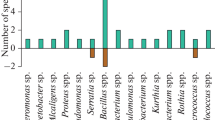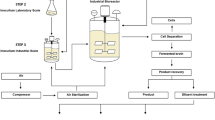Abstract
Hydrocarbon-decomposing microorganisms identified as representatives of the genera Pseudomonas, Rhodococcus, Acinetobacter, Kocuria, Raoultella, and Candida have been isolated from the oil-contaminated soil samples of the Middle Ob region. They have been screened for the ability to decompose various classes of hydrocarbons in a wide temperature range (6–37°C), in acid media (up to pH 4), and at increased salinity (up to 3%), for the ability to produce biosurfactants, and for the presence of genes encoding enzymes responsible for hydrocarbon decomposition. A microbial consortium has been suggested as the basis of a biological preparation for bioremediation of oil-contaminated soils in the Middle Ob region, including strains of Candida fluviatilis 24p-51, Rhodococcus erythropolis 24-44, Acinetobacter calcoaceticus 7-43, and Pseudomonas extremaustralis 7-31. The modes of cultivation and lyophilization of biomass have been determined for these microorganisms. The efficiency of degradation of oil hydrocarbons by the developed microbial consortium has been evaluated in laboratory model systems. The degree of oil degradation by the microbial consortium in the liquid mineral medium was 56%; in the model soil, 22% in 10 days at 24°C.

Similar content being viewed by others
REFERENCES
N. A. Avetov, O. L. Kuznetsov, and E. A. Shishkonakova, “Soils of oligomesotrophic and mesotrophic bogs in the boreal zone of West Siberia: possibilities of botanical diagnostics within the framework of the type of mesotrophic peat soils,” Eurasian Soil Sci. 54, 689–701 (2021). https://doi.org/10.1134/S1064229321030029
N. A. Avetov and E. A. Shishkonakova, “Oil pollution of soils in the taiga zone of Western Siberia,” Byull. Pochv. Inst. im. V.V. Dokuchaeva, No. 68, 45–55 (2011).
A. A. Vetrova, A. A. Ivanova, A. E. Filonov, V. A. Zabelin, A. B. Gafarov, S. L. Sokolov, I. A. Nechaeva, I. F. Puntus, and A. M. Boronin, “Biodegradation of oil by the strains and principles of composition of microbial consortiums for cleaning the environment from petroleum hydrocarbons,” Izv. Tul’sk. Gos. Univ., Estestv. Nauki, No. 2, 241–257 (2013).
Yu. S. Drugov and A. A. Rodin, Ecological Analysis of in Case of Spills of Oil and Petroleum Products: Practical Guide (BINOM. Laboratoriya Znanii, Moscow, 2007) [in Russian].
T. Yu. Izmalkova, O. I. Sazonova, S. L. Sokolov, I. A. Kosheleva, and A. M. Boronin, “The P-7 incompatibility group plasmids responsible for biodegradation of naphthalene and salicylate in fluorescent pseudomonads,” Microbiology (Moscow) 74, 290–295 (2005).
M. S. Kuyukina and I. B. Ivshina, RF Patent No. 2180276, Byull. Izobret., No. 7 (2002).
T. Maniatis, E. F. Fritsch and J. Sambrook, Molecular Cloning: A Laboratory Manual (Cold Spring Harbor Laboratory, New York, 1982; Mir, Moscow, 1984).
PND F 16.1:2.2.22-98. Guide for Measurement of Mass Fraction of Petroleum Products in Mineral, Organogenic, Organomineral Soils and Bottom Sediments by IR Spectrometry (Moscow, 1998) [in Russian].
K. V. Petrikov, Candidate’s Dissertation in Chemistry (Moscow, 2011).
Practical Guide on Soil Science, Ed. by N. F. Ganzhara (Agrokonsalt, Moscow, 2002) [in Russian].
O. I. Sazonova, A. A. Vetrova, A. B. Gafarov, and S. L. Sokolov, “Isolation of epiphytic strains Aureobasidium pullulans producing high-molecular extracellular polysaccharides,” Izv. Tul’sk. Gos. Univ., Estestv. Nauki, No. 4, 24–31 (2017).
O. I. Sazonova, A. A. Vetrova, R. A. Streletskii, A. B. Gafarov, I. A. Kosheleva, A. E. Filonov, and S. L. Sokolov, “Strains Pseudomonas extremaustralis 7–31 and Pseudomonas fluorescens 7–41 degrading aliphatic and aromatic hydrocarbons,” Izv. Tul’sk. Gos. Univ., Estestv. Nauki, No. 3, 31–43 (2019).
V. P. Seredina, E. V. Kolesnikova, V. A. Kondykov, A. I. Nepotrebnyi, and S. A. Ognev, “Specific impact of oil pollution on soils of the middle taiga of Western Siberia,” Neft. Khoz., No. 5, 108–112 (2017).
S. Ya. Trofimov, A. V. Arzamazova, R. R. Kinzhaev, N. A. Avetov, and M. M. Karpukhin, “Mineralization of organic matter in petroleum-polluted and background soils of the Middle Ob region in laboratory conditions,” Vestn. Mosk. Univ., Ser. 17: Pochvoved., No. 2, 51–56 (2021).
R. Alonso, A. Martín, T. Peláez, M. Marín, M. Rodríguez-Creixéms, and E. Bouza, “An improved protocol for pulsed-field gel electrophoresis typing of Clostridium difficile,” J. Medical Microbiol. 54 (2), 155–157 (2005). https://doi.org/10.1099/jmm.0.45808-0
E. Antoniou, S. Fodelianakis, E. Korkakaki, and N. Kalogerakis, “Biosurfactant production from marine hydrocarbon-degrading consortia and pure bacterial strains using crude oil as carbon source,” Front. Microbiol. 6, 274 (2015). https://doi.org/10.3389/fmicb.2015.00274
M. G. Barron, D. N. Vivian, R. A. Heintz, and U. H. Yim, “Long-term ecological impacts from oil spills: comparison of Exxon Valdez, Hebei Spirit, and Deepwater Horizon,” Environ. Sci. Technol. 54 (11), 6456–6467 (2020). https://doi.org/10.1021/acs.est.9b05020
BLAST. http://www.ncbi.nlm.nih.gov/BLAST.
R. J. W. Brooijmans, M. I. Pastink, and R. J. Siezen, “Hydrocarbon-degrading bacteria: the oil-spill clean-up crew,” Microb. Biotechnol. 2 (6), 587–594 (2009). https://doi.org/10.1111/j.1751-7915.2009.00151.x
L. Cabral, P. Giovanella, E. P. Pellizzer, E. H. Teramoto, C. H. Kiang, and L. D. Sette, “Microbial communities in petroleum-contaminated sites: structure and metabolisms,” Chemosphere 286 (2), 131752 (2022). https://doi.org/10.1016/j.chemosphere.2021.131752
A. Dasgupta, R. Saikia, and P. J. Handique, “Mapping the bacterial community in Digboi oil refinery, India by high-throughput sequencing approach,” Curr. Microbiol. 75 (11), 1441–1446 (2018). https://doi.org/10.1007/s00284-018-1541-x
J. Davies and W. Evans, “Oxidative metabolism of naphthalene by soil pseudomonads. The ring-fission mechanism,” Biochem. J. 91 (2), 251–261 (1964). https://doi.org/10.1042/bj0910251
L. Derguine-Mecheri, S. Kebbouche-Gana, and D. Djenane, “Biosurfactant production from newly isolated Rhodotorula sp. YBR and its great potential in enhanced removal of hydrocarbons from contaminated soils,” World J. Microbiol. Biotechnol. 37 (1), 18 (2021). https://doi.org/10.1007/s11274-020-02983-3
H. P. Doddamani and H. Z. Ninnekar, “Biodegradation of carbaryl by a Micrococcus species,” Curr. Microbiol. 43 (1), 69–73 (2001). https://doi.org/10.1007/s002840010262
P. Elumalai, P. Parthipan, M. Huang, B. Muthukumar, L. Cheng, M. Govarthanan, and A. Rajasekar, “Enhanced biodegradation of hydrophobic organic pollutants by the bacterial consortium: Impact of enzymes and biosurfactants,” Environ. Pollut. 289, 117956 (2021). https://doi.org/10.1016/j.envpol.2021.117956
C. G. T. Evans, D. Herbert, and D. W. Tempest, “The continuous cultivation of microorganisms: 2. Construction of a chemostat,” in Methods in Microbiology (Elsevier, Amsterdam, 1970), Vol. 2, Ch. 13, pp. 277–327.
W. Evans, H. Fernley, and E. Griffiths, “Oxidative metabolism of phenanthrene and anthracene by soil pseudomonads. The ring-fission mechanism,” Biochem. J. 95 (3), 819–831. 1965). https://doi.org/10.1042/bj0950819
GeneJET PCR Purification Kit. https://www.thermofisher.com/order/catalog/product/K0702.
J. J. Germida, C. M. Frick, and R. E. Farrell, “Phytoremediation of oil-contaminated soils,” in Developments in Soil Science (Elsevier, Amsterdam, 2002), Vol. 28, Part 2, pp. 169–186. https://doi.org/10.1016/S0166-2481(02)80015-0
J. B. Herrick, K. G. Stuart-Keil, W. C. Ghiorse, and E. L. Madsen, “Natural horizontal transfer of a naphthalene dioxygenase gene between bacteria native to a coal tar-contaminated field site,” Appl. Environ. Microbiol. 63 (6), 2330–2337 (1997). https://doi.org/10.1128/aem.63.6.2330-2337.1997
H. Kiyohara, S. Torigoe, N. Kaida, T. Asaki, T. Iida, H. Hayashi, and N. Takizawa, “Cloning and characterization of a chromosomal gene cluster, pah, that encodes the upper pathway for phenanthrene and naphthalene utilization by Pseudomonas putida OUS82,” J. Bacteriol. 176 (8), 2439–2443 (1994). https://doi.org/10.1128/jb.176.8.2439-2443.1994
E. Koshlaf and A. Ball, “Soil bioremediation approaches for petroleum hydrocarbon polluted environments,” AIMS Microbiol. 3 (1), 25–49 (2017). https://doi.org/10.3934/microbiol.2017.1.25
M. J. Larkin and M. J. Day, “The metabolism of carbaryl by three bacterial isolates, Pseudomonas spp. (NCIB 12042 & 12043) and Rhodococcus sp. (NCIB 12038) from garden soil,” J. Appl. Bacteriol. 60 (3), 233–242 (1986). https://doi.org/10.1111/j.1365-2672.1986.tb01078.x
A. D. Laurie and G. Lloyd-Jones, “Quantification of phnAc and nahAc in contaminated New Zealand soils by competitive PCR,” Appl. Environ. Microbiol. 66 (5), 1814–1817 (2000). https://doi.org/10.1128/AEM.66.5.1814-1817.2000
Ł. Ławniczak, M. Woźniak-Karczewska, A. P. Loibner, H. J. Heipieper, and Ł. Chrzanowski, “Microbial degradation of hydrocarbons—basic principles for bioremediation: a review,” Molecules 25 (4), 856 (2020). https://doi.org/10.3390/molecules25040856
X. Li, L. Zhao, and M. Adam, “Biodegradation of marine crude oil pollution using a salt-tolerant bacterial consortium isolated from Bohai Bay, China,” Mar. Pollut. Bull. 105 (1), 43–50 (2016). https://doi.org/10.1016/j.marpolbul.2016.02.073
A. R. Markande, D. Patel, and S. Varjani, “A review on biosurfactants: properties, applications and current developments,” Bioresour. Technol. 330, 124963 (2021).
G. T. Mehetre, S. G. Dastager, and M. S. Dharne, “Biodegradation of mixed polycyclic aromatic hydrocarbons by pure and mixed cultures of biosurfactant producing thermophilic and thermo-tolerant bacteria,” Sci. Total Environ. 679, 52–60 (2019).
S. Mnif, M. Chamkha, and S. Sayadi, “Isolation and characterization of Halomonas sp. strain C2SS100, a hydrocarbon-degrading bacterium under hypersaline conditions,” J. Appl. Microbiol. 107 (3), 785–794 (2009). https://doi.org/10.1111/j.1365-2672.2009.04251.x
Y. Nie, C.-Q. Chi, H. Fang, J.-L. Liang, S.-L. Lu, G.‑L. Lai, Y.-Q. Tang, and X.-L. Wu, “Diverse alkane hydroxylase genes in microorganisms and environments,” Sci. Rep. 4 (1), 4968 (2014).
S. Patel, A. Homaei, S. Patil, and A. Daverey, “Microbial biosurfactants for oil spill remediation: pitfalls and potentials,” Appl. Microbiol. Biotechnol. 103 (1), 27–37 (2019). https://doi.org/10.1007/s00253-018-9434-2
V. Patel, A. Sharma, R. Lal, N. A. Al-Dhabi, and D. Madamwar, “Response and resilience of soil microbial communities inhabiting in edible oil stress/contamination from industrial estates,” BMC Microbiol. 16 (1), 50 (2016). https://doi.org/10.1186/s12866-016-0669-8
R. Perdigão, C. M. R. Almeida, F. Santos, M. F. Carvalho, and A. P. Mucha, “Optimization of an autochthonous bacterial consortium obtained from beach sediments for bioremediation of petroleum hydrocarbons,” Water 13 (1), 66 (2020). https://doi.org/10.3390/w13010066
A. V. Poliakova, I. I. Chernov, and N. S. Panikov, “Yeast biodiversity in hydromorphic soils with reference to grass-Sphagnum swamp in Western Siberia and the hammocky tundra region (Barrow, Alaska),” Mikrobiologiia 70 (5), 714–20 (2001). https://doi.org/10.1023/A:1012328710111
R. A. Rosselló-Mora, J. Lalucat, and E. García-Valdés, Comparative biochemical and genetic analysis of naphthalene degradation among Pseudomonas stutzeri strains,” Appl. Environ. Microbiol. 60 (3), 966–972 (1994). https://doi.org/10.1128/aem.60.3.966-972.1994
J. Sambrook and D. W. Russell, Molecular Cloning: A Laboratory Manual (Cold Spring Harbor Laboratory Press, New York, 2001).
J. Sanseverino, B. M. Applegate, J. M. King, and G. S. Sayler, “Plasmid-mediated mineralization of naphthalene, phenanthrene, and anthracene,” Appl. Environ. Microbiol. 59 (6), 1931–1937 (1993). https://doi.org/10.1128/aem.59.6.1931-1937.1993
K. N. Timmis, P. R. Lehrbach, S. Harayama, R. H. Don, N. Mermod, S. Bas, R. Leppik, A. J. Weightman, W. Reineke, and H. J. Knackmuss, “Analysis and manipulation of plasmid-encoded pathways for the catabolism of aromatic compounds by soil bacteria,” in Plasmids in Bacteria, Ed. by D. R. Helinski, S. N. Cohen, (Plenum, New York, 1985), pp. 719–739.
M. Tyagi, M. M. R. da Fonseca, and C. C. C. R. de Carvalho, “Bioaugmentation and biostimulation strategies to improve the effectiveness of bioremediation processes,” Biodegradation 22 (2), 231–241 (2011). https://doi.org/10.1007/s10532-010-9394-4
S. Viggor, J. Juhanson, M. Jõesaar, M. Mitt, J. Truu, E. Vedler, and A. Heinaru, “Dynamic changes in the structure of microbial communities in Baltic Sea coastal seawater microcosms modified by crude oil, shale oil or diesel fuel,” Microbiol. Res. 168 (7), 415–427 (2013). https://doi.org/10.1016/j.micres.2013.02.006
V. Walter, C. Syldatk, and R. Hausmann, “Screening concepts for the isolation of biosurfactant producing microorganisms,” in Biosurfactants, Ed. by R. Sen (Springer-Verlag, New York, 2010), pp. 1–13. https://doi.org/10.1007/978-1-4419-5979-9_1
Y. Yang, J. Wang, J. Liao, S. Xie, and Y. Huang, “Abundance and diversity of soil petroleum hydrocarbon-degrading microbial communities in oil exploring areas,” Appl. Microbiol. Biotechnol. 99 (4), 1935–1946 (2015). https://doi.org/10.1007/s00253-014-6074-z
Z.-F. Zhou, M.-X. Wang, X.-H. Zuo, and Y.-H. Yao, “Comparative investigation of bacterial, fungal, and archaeal community structures in soils in a typical oilfield in Jianghan, China,” Arch. Environ. Contam. Toxicol. 72 (1), 65–77 (2017). https://doi.org/10.1007/s00244-016-0333-1
S. Zinjarde, M. Apte, P. Mohite, and A. R. Kumar, “Yarrowia lipolytica and pollutants: Interactions and applications,” Biotechnol. Adv. 32 (5), 920–933 (2014). https://doi.org/10.1016/j.biotechadv.2014.04.008
Funding
This work was carried out within the framework of state assignment of the Ministry of Science and Higher Education of the Russian Federation no. № 121041300098-7 and, partly, within the framework of the development program of the Interdisciplinary Scientific and Educational School of Lomonosov Moscow State University “Future of the Planet and Global Environmental Changes.”
Author information
Authors and Affiliations
Corresponding author
Ethics declarations
The authors declare that they have no conflicts of interest.
Additional information
Translated by T. Chicheva
Supplementary Information
Rights and permissions
About this article
Cite this article
Vetrova, A.A., Trofimov, S.Y., Kinzhaev, R.R. et al. Development of Microbial Consortium for Bioremediation of Oil-Contaminated Soils in the Middle Ob Region. Eurasian Soil Sc. 55, 651–662 (2022). https://doi.org/10.1134/S1064229322050106
Received:
Revised:
Accepted:
Published:
Issue Date:
DOI: https://doi.org/10.1134/S1064229322050106




